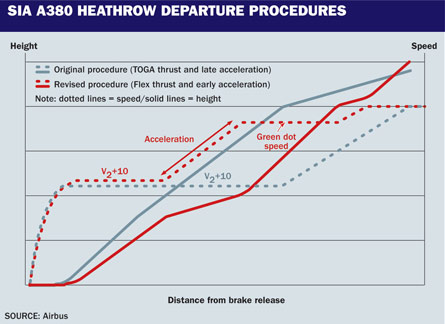Singapore Airlines has been cleared to operate a more efficient Airbus A380 departure procedure at London Heathrow after a year-long trial at the world's most noise sensitive international airport.
The airline has worked with Airbus, the airport's operator BAA and UK air navigation service provider NATS to develop and approve the procedure, which has now been implemented and saves around 300kg (660lb) of fuel on every departure. Airbus says NOx emissions in the first 1,000ft (305m) are also cut by 10% .
According to Airbus senior acoustics engineer Nicolas Mouney the idea came originally from an SIA pilot, Capt Ray Chaudhury. "When the airline introduced the A380 at Heathrow in March 2008, it continued with the procedure developed for its Boeing 747-400s to comply with London noise limits, which was to use TOGA take-off/go around [full] thrust for maximum climb," he says. "After positive feedback with regards to acoustic performance, the captain suggested a revised procedure using the 'Flex' flexible lower thrust take-off setting."
 |
|---|
© Flightglobal/Max Kingsley-Jones |
Although "Flex" is the usual A380 take-off thrust setting at other airports, for Heathrow departures SIA's original procedure required TOGA thrust and a rapid climb to 1,500ft. The crew then brought thrust back to "CL" managed climb thrust mode and continued the climb at a speed of V2 +10 (usually 165-170kt/305-315km/h) to 4,000ft before retracting the flaps and beginning the normal acceleration.
This operation was in accordance with Heathrow's noise abatement procedure requirements that define altitude constraints and a minimum climb gradient up to 4,000ft, which essentially stipulates to ascend to this height as quickly as possible.

The new procedure "makes use of A380's good low-level performance and low noise characteristics", says Mouney, using the lower Flex thrust setting for take-off and then acceleration after selecting CL thrust at 1,500ft to "green-dot speed". This speed, typically around 230kt, is indicated as a green dot on the airspeed indicator and gives the optimum climb gradient. The earlier acceleration allows the crew to retract the flaps, thereby reducing drag, fuel burn and emissions, says Mouney.
The A380 is the first Airbus type to have a "noise" function incorporated into its flight management system, enabling the target air speed to be programmed for a given segment of departure/initial climb, says Mouney. "This provides an automated management of the noise segment, minimising crew work load," he says.
Once 4,000ft is reached, the aircraft automatically resumes a normal climb and speed schedule.
The revised procedure was tested between October 2008 and November 2009 as BAA wanted a full year to evaluate whether there were any seasonal effects on noise monitoring.
BAA says it intends to make Heathrow's other A380 operators - Emirates and Qantas - aware of the positive results of the SIA trial. "We look to work with all airlines in order to minimise noise and emissions through optimal departure procedures," it adds.
SIA uses revised thrust and FMS settings for the new procedure
Source: Flight International
















